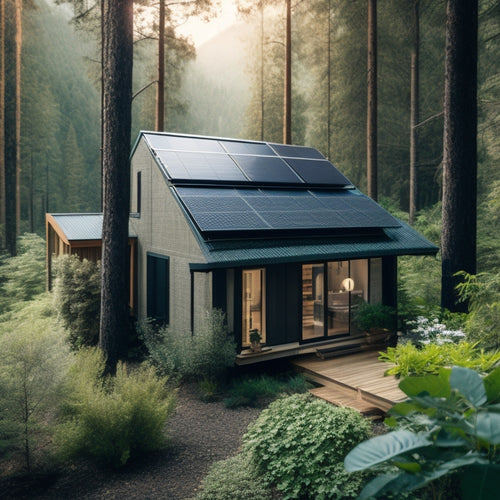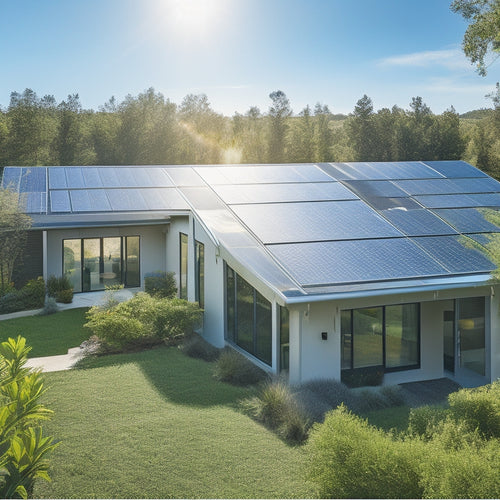
Home Backup Solar System
Share
You're investing in a home backup solar system to gain control over your energy needs, ensuring a steady supply of clean power during grid outages and greatly reducing your reliance on the utility grid. This setup integrates solar panels with advanced battery storage, allowing you to generate and store excess energy for later use. During outages, the system seamlessly shifts to backup mode, providing uninterrupted power to critical appliances. By choosing a home backup solar system, you'll not only reduce your carbon footprint but also potentially save on electricity bills. Now, learn how to optimize your system's performance and tailor it to your specific energy needs.
The Essentials
- A home backup solar system provides energy independence and control, empowering homeowners to generate clean energy and reduce reliance on the grid.
- Integration with battery storage ensures uninterrupted power supply during outages, supporting the operation of critical appliances like refrigerators and medical equipment.
- Advanced battery technology enables seamless transition to backup mode, storing excess energy for use during non-sunny periods and minimizing energy losses.
- Homeowners can sell excess energy back to utility companies through grid tie inverter functionality, optimizing energy independence and cost savings.
- Effective assessment of energy demands and appliance management is crucial for designing a tailored solar system that meets specific energy needs during outages.
Energy Independence Matters Most
When you invest in a home backup solar system, you're not just preparing for power outages - you're taking control of your energy needs.
By integrating a home battery storage system, you can reduce your reliance on the grid during outages and lower your electricity bills by storing excess energy generated by your solar panels.
You'll have the power without interruption, ensuring your home remains functional and comfortable even when the grid goes down.
Power Without Interruption
One critical aspect of a home backup solar system is its ability to provide power without interruption, guaranteeing your energy independence in the face of grid failures or natural disasters.
You expect your system to seamlessly switch to backup mode when the grid goes down, and advanced battery technology makes this possible. With a high-efficiency solar panel array, your system can capture and store excess energy during the day, providing a reliable source of power when you need it most.
By leveraging renewable energy storage and advanced battery systems, homeowners can alleviate the burden of high energy bills and reduce grid dependence, providing them with greater energy independence and potential cost savings.
In the event of an outage, your home backup solar system automatically detects the grid failure and switches to backup mode. This guarantees that your critical appliances, such as refrigeration, lighting, and communication systems, remain operational.
The advanced battery technology and smart inverter system work together to optimize energy storage and distribution, providing a steady flow of power to your home.
With a home backup solar system, you can enjoy uninterrupted power, even when the grid fails, and maintain your independence from the unpredictable energy grid.
Freedom From Grid
Most homeowners opting for a home backup solar system prioritize energy independence above all else. You're not just looking for a backup power source, but a way to break free from the grid's constraints.
With a home backup solar system, you'll enjoy the freedom to generate your own clean energy, reducing your reliance on the grid. This means you'll be less affected by power outages, rate hikes, and environmental concerns.
By utilizing an All in One Solar Power System, you can simplify the shift to renewable energy and guarantee a steady power supply even when the grid is down.
Solar panel benefits include a reduced carbon footprint, lower energy bills, and increased property value. Renewable energy innovations have made it possible to store excess energy generated during the day for use during the night or on cloudy days. This means you can enjoy a steady supply of power, even when the sun isn't shining.
Reduced Carbon Footprint Guaranteed
By installing a home backup solar system, you'll be switching to an eco-friendly energy source that greatly reduces your reliance on fossil fuels, much like utilizing renewable energy to power your home.
This shift not only helps the environment but also leads to lower electricity bills, thanks to the energy efficiency of solar power solutions.
This means you'll be generating clean energy while lowering your emissions, contributing to a cleaner environment.
With a solar-powered backup system, you're guaranteed to reduce your carbon footprint, making a positive impact on the planet.
Eco-Friendly Energy Source
Your home backup solar system employs the power of photovoltaic cells to convert sunlight into electricity, providing a clean and renewable energy source that greatly reduces your carbon footprint.
This eco-friendly energy source is an important step towards a more sustainable future, and you're at the forefront of this movement. By capturing the power of the sun, you're no longer reliant on fossil fuels, which means fewer greenhouse gas emissions and less pollution.
The solar panel benefits are numerous, from reducing your energy bills to increasing your property value. With a renewable energy source like solar power, you're not only helping the environment but also securing your energy independence.
You'll have the freedom to generate your own electricity, without being tied to the grid or affected by price hikes. By switching to an eco-friendly energy source, you're taking a vital step towards a cleaner, greener, and more sustainable tomorrow.
Lower Emissions Guaranteed
Frequently, homeowners who invest in a home backup solar system experience a significant reduction in their carbon footprint. By utilizing the power of solar technology, you'll be generating clean energy and decreasing your reliance on fossil fuels. This, in turn, leads to a substantial decrease in greenhouse gas emissions, contributing to a healthier environment.
With a home backup solar system, you can expect a notable reduction in your carbon footprint, thanks to the system's ability to store excess energy generated during the day for use during the night or on cloudy days.
This stored energy guarantees a continuous supply of power, minimizing the need for traditional energy sources and further reducing your environmental impact.
Grid Tie Inverter Function
You'll need to understand how your grid tie inverter functions to maximize your home backup solar system's efficiency.
When it comes to ensuring a continuous power supply during outages and grid failures, a reliable solar backup system is essential.
During the grid connection process, the inverter synchronizes its AC output with the grid's voltage and frequency.
In inverter synchronization mode, it continuously monitors and adjusts its output to match the grid's waveform, ensuring a seamless and safe transfer of energy.
Grid Connection Process
The grid connection process begins with the grid tie inverter, a critical component that synchronizes the solar array's output with the utility grid's voltage and frequency, guaranteeing a seamless and efficient energy transfer.
You'll need to ascertain the inverter is properly installed and configured to meet the grid's requirements. During the installation process, the inverter is connected to the solar array and the utility grid.
You'll then need to program the inverter with the grid's voltage and frequency parameters, as well as the maximum power output of your solar array.
Once the inverter is configured, it will monitor the grid's voltage and frequency in real-time, adjusting the solar array's output to match the grid's conditions.
This guarantees a safe and efficient grid connection, allowing you to sell excess energy back to the utility company and offset your energy bills.
The grid connection process is a critical step in creating a reliable and efficient home backup solar system, giving you the freedom to generate your own clean energy and reduce your reliance on the grid.
Inverter Synchronization Mode
Inverter Synchronization Mode (Grid Tie Inverter Function)
When you're investing in a home backup solar system, understanding how your inverter works is essential. Inverter Synchronization Mode, also known as Grid Tie Inverter Function, is a vital component of your system. This mode guarantees that your inverter operates in harmony with the grid, maximizing inverter efficiency and providing synchronization benefits.
Here's how it works:
| Grid Status | Inverter Mode | System Behavior |
|---|---|---|
| Grid available | Grid tie | Inverter synchronizes with grid frequency and voltage |
| Grid unavailable | Backup mode | Inverter provides power to your home, independent of the grid |
| Grid fault | Fault mode | Inverter shuts down to prevent islanding |
| Grid reconnect | Grid tie | Inverter resynchronizes with the grid |
| System maintenance | Standby mode | Inverter is idle, awaiting system restart |
In this mode, your inverter continuously monitors the grid's frequency and voltage, guaranteeing a seamless shift between grid-tied and backup modes. This synchronization benefits your system by allowing it to adapt to changing grid conditions, maximizing your energy independence and freedom.
Assess Your Energy Demands
You need to determine your daily energy consumption to size your home backup solar system correctly.
With the rise of renewable energy storage, it's crucial to accurately calculate your energy needs to guarantee a seamless changeover to backup power.
To do this, calculate your total daily energy usage in watt-hours (Wh) by adding up the power ratings of all appliances you want to back up.
Start by gathering the power ratings of each appliance, which can usually be found on the manufacturer's label or in the user manual.
Daily Energy Consumption
By morning, your household is already consuming energy - from the coffee maker to the lights, every device is drawing power from the grid. Understanding your daily energy consumption is essential to designing an effective home backup solar system. You need to assess your energy demands to determine the size of the solar panel array and battery bank required to meet your needs.
To get started, track your energy usage patterns over a week or a month. Identify the devices that consume the most energy and their usage patterns. Are there any energy-intensive appliances that you can replace with more energy-efficient alternatives? Analyze your consumption patterns to identify opportunities for energy efficiency improvements.
Here is a sample breakdown of daily energy consumption:
| Time of Day | Energy Consumption (kWh) |
|---|---|
| Morning (6am-10am) | 2.5 |
| Day (10am-6pm) | 4.0 |
| Evening (6pm-10pm) | 3.5 |
| Night (10pm-6am) | 1.5 |
| Total | 11.5 |
Appliance Power Ratings
What determines the energy demands of your appliances? It's crucial to know the power ratings of each device to assess your energy demands accurately. You'll need to gather the wattage and voltage requirements of each appliance to determine their energy consumption. This information can usually be found on the device's nameplate, manual, or manufacturer's website.
When evaluating appliance power ratings, consider the efficiency of each device. Look for appliances with high Energy Star ratings, which indicate they meet energy efficiency standards. Efficient appliances consume less power while providing the same performance, reducing your overall energy demands.
Effective power management is critical in a home backup solar system. By understanding the power ratings of your appliances, you can prioritize energy allocation during outages or periods of limited solar generation.
This guarantees you can power essential appliances like refrigerators, medical equipment, or communication devices when you need them most. Accurate assessment of your energy demands enables you to design a solar system that meets your needs, providing you with the freedom and independence you desire.
Longer Battery Life Guaranteed
You require a home backup solar system that can provide prolonged power storage during grid outages.
To achieve this, you need a battery system that can store excess energy generated by your solar panels during the day for use at night or during extended power outages.
Prolonged Power Storage
A reliable home backup solar system requires prolonged power storage to guarantee a steady supply of electricity during extended grid outages. You need a system that can store excess energy generated by your solar panels during the day for use at night or during power outages.
This is where advanced battery technology comes in. With the latest energy storage solutions, you can enjoy prolonged power storage, ensuring your home remains powered even when the grid is down.
When selecting a battery for your home backup solar system, look for ones that offer high energy efficiency. This means they can store and discharge energy with minimal losses, maximizing your energy independence.
Additionally, consider batteries with a long lifespan, typically 10-15 years, to minimize replacement costs. By choosing the right battery technology, you can enjoy a steady supply of electricity, even during extended grid outages, giving you the freedom to live life on your own terms.
Frequently Asked Questions
Can I Add More Solar Panels to My Existing System Later?
You can expand your existing solar setup by adding more panels, but you'll need to guarantee solar panel compatibility and assess your system's capacity for expansion, considering factors like inverter capacity and electrical infrastructure.
Do Home Backup Solar Systems Require Regular Maintenance?
Silky solar silence surrounds you, but don't be fooled - you'll need to scrutinize your system regularly. You'll want to check battery longevity and adjust maintenance frequency to guarantee peak performance, so you can stay powered up and free from grid dependence.
Will My Appliances Work Normally During a Power Outage?
During a power outage, you'll be relieved to know that your appliances will work normally as long as they're compatible with your system's output; however, it's essential to confirm appliance compatibility to avoid any disruptions or damage.
Can I Use My Solar System During the Night or on Cloudy Days?
You're like a sailor steering through darkness, seeking a guiding light to lead you through the night; your solar energy storage system is that lighthouse, allowing you to utilize the sun's power for nighttime usage, even on cloudy days, when the sun's rays are veiled.
Are Home Backup Solar Systems Eligible for Government Incentives?
You're eligible for government incentives, specifically tax credits, through various incentive programs, which can greatly offset the cost of your system, making it more affordable and increasing your energy independence.
Final Thoughts
As you set out on your expedition to energy independence, it's no coincidence that you're considering a home backup solar system. By now, you've realized that reduced carbon footprint and grid tie inverter functionality are non-negotiables. You've assessed your energy demands and are ready to reap the benefits of longer battery life. It's not a coincidence that you're on the cusp of a life-changing decision. With a home backup solar system, you'll experience the satisfaction of powering your life on your own terms - and that's no accident.
Related Posts
-

Top 10 Off Grid Camping Gear Must-Haves
When you're off-grid camping, the right gear is crucial for a smooth expedition. Start with a durable, weather-resist...
-

Off Grid Solar Batteries
As you shift to off-grid living, you'll rely on high-performance solar batteries to store excess energy generated by ...
-

Installing Metal Solar Roofs for Maximum Energy Efficiency
Installing metal solar roofs can drastically enhance your home's energy efficiency and durability. These roofs withst...


